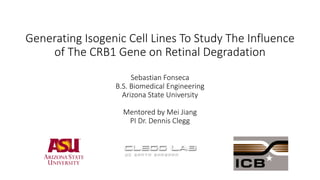
Retinal Dystrophies and CRB1
- 1. Generating Isogenic Cell Lines To Study The Influence of The CRB1 Gene on Retinal Degradation Sebastian Fonseca B.S. Biomedical Engineering Arizona State University Mentored by Mei Jiang PI Dr. Dennis Clegg
- 2. Retinal Dystrophies and CRB1 • Retinitis pigmentosa (RP) and leber congenital amaurosis (LCA). • Chronic and incurable diseases. • Eventually lead to almost complete loss of sight. • Usually detected in early childhood stages. http://www.isotineeyedrops.com/eye-care/symptoms-of-retinitis-pigmentosa/ http://www.medscape.com/viewarticle/774365 http://www.blindness.org/leber-congenital-amaurosis
- 3. Research Objectives • Recreate a mutation at a specific site in the CRB1 gene that has been associated with the development of RP and LCA. • Carry out the initial steps of the CRISPR/Cas9 genome editing technique creating nine different clones with mutations in the CRB1 gene. • Create isogenic cell lines that possess the p.Cys948Tyr, p.Cys698Arg and p.Leu878Pro mutations in order to observe if the phenotype associated to retinal degradation was in any way correlated. Bujakowska, K., Audo, I., Mohand-Saïd, S., Lancelot, M.-E., Antonio, A., Germain, A., … Zeitz, C. (2012). CRB1 mutations in inherited retinal dystrophies. Human Mutation, 33(2), 306–315. http://doi.org/10.1002/humu.21653
- 4. Methodology: CRISPR/Cas 9 Complex • Clustered regularly interspaced short palindromic repeats (CRISPR). • Use of donor DNA in order to use the cell’s natural repair mechanisms to generate a mutation in the genetic code of a group of cells. • Use of an endonuclease (Cas9) and a small guide RNA in order to cut a cell’s DNA at the site of a specific mutation for CRB1.
- 5. Methods and Experimental Techniques 1. Minipreparation 2. Vector digestion and dephosphorylation 3. Oligos annealing and phosphorylation 4. Ligation 5. Transformation and colony selection
- 6. Minipreparation (miniprep) • Miniprep is a technique carried out in order to obtained purified DNA from cells. • The procedure involves the use of several buffers that help cell lysis, alongside centrifuge spinning cycles that allow unwanted material to be discarded.
- 7. Vector Digestion and Dephosphorylation • Vector digestion consists of creating a double strand break in the DNA of the vector. • This break will be used to insert the oligos sequence complementary to the site of the mutation. • Vectors have to be depohsphorylated in order to avoid self-ligation. • Self-ligation occurs when the two ends of the vector attach to each other and therefore do not allow for the olligos to be inserted.
- 8. Oligos annealing and phosphorylation • The forward and reverse oligos sequences are recombined to form double stranded DNA. • Phosphorylation functions as a recognition process for the oligos to attach to the ‘break’ site of the vector. Ligation • In this step the oligos are attached to the vector with the help of specific enzymes called ligases. • Many of the failed transformation procedures are related to complications in this step.
- 9. Transformation and Colony Selection • The vectors with the oligos sequences inserted in them are transfected into bacterial cells in order to increase the amount of DNA that can be later used.
- 11. Vector Digestion
- 12. Annealing
- 13. Ligation Electrophoresis Ligation products Digested pgRNA-CKB vector 1kb ladder
- 14. Successful Ligation and Transformation • Bacteria are growing on the ampicillin plate after using modified ligation protocol with oligos dilution.
- 15. Validation of Transformation with Gel Electrophoresis • Bacteria were collected from the ampicillin plate and purified plasmid DNA was obtained by using the miniprep protocol. • The plasmid DNA was mixed with restriction enzymes (Esp3I), however because of the absence of the original sequence in the vector, the enzymes could not generate a double strand break.
- 16. Sequencing
- 17. Future Work • Deliver the vector containing the sgRNA alongisde a sample of donor DNA (containing the p.Cys948Tyr mutation) into a CRISPR line of mammalian cells that already contain the Cas9 knock-in protein. • Expand the group of cells containing the desired mutation. • Perform validation and sequencing of these isogenic cell lines.
- 18. Questions
- 19. Acknowledgements • Dr. Linda Petzold • Stephanie Lupo • ICB • SABRE Program and participants • Family and friends Clegg Lab: • Professor Dennis Clegg • Dr. Mei Jiang • Katharine McLean • Britney Pennington • Leah Foltz • Kelsy Siegel • Qirui Hu • Tracy Clevenger
Hinweis der Redaktion
- Retinal dystrophies is what we are interested in. RP and LCA are related to RPE cells.
- IDT is company we bought oligos from.
- Normal Agarose gel
- Synergel – different gel that can recognize small DNA for annealling. They migrate at different speeds on the gel.
- PlasmidSafe was used for wells 2 and 3 (empty vector and ligated vector). Wells 2 and 3 are placed with PlasmidSafe. Recognition site is destroyed once vector has new DNA.
- Donor DNA is designed artificially. Knock-in for Cas9, we induce the cells to induce the expression of Cas9.